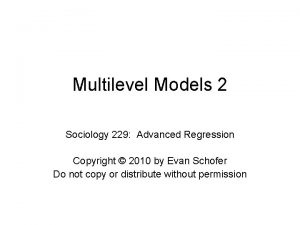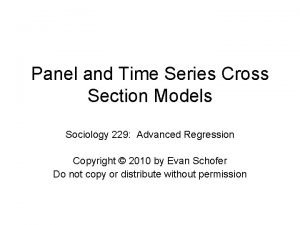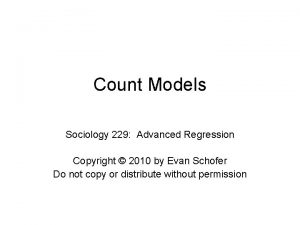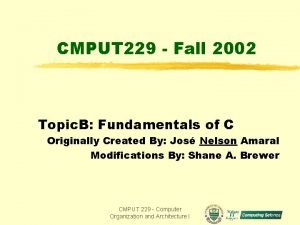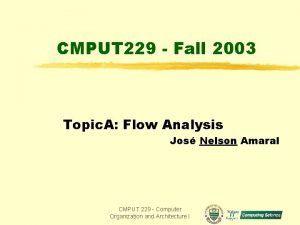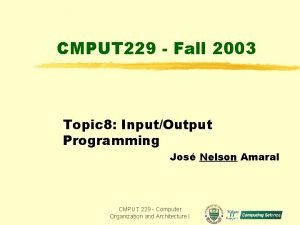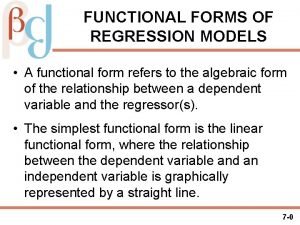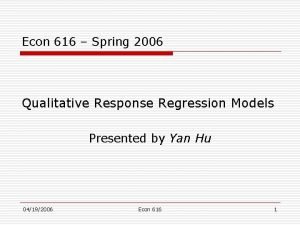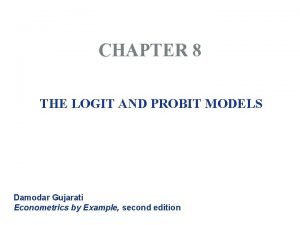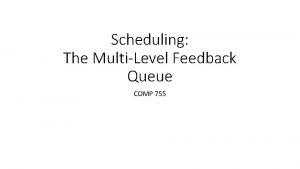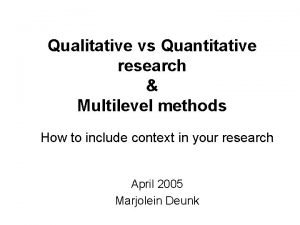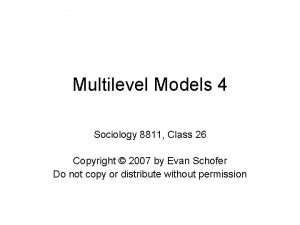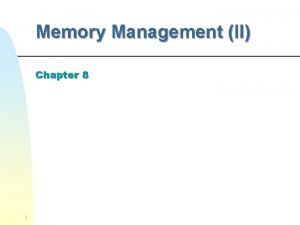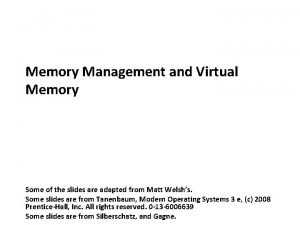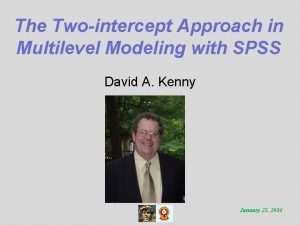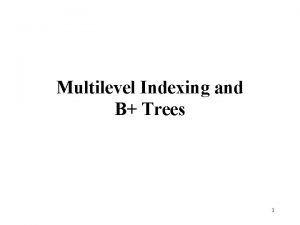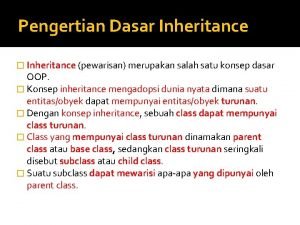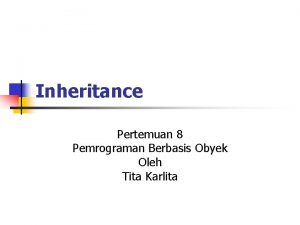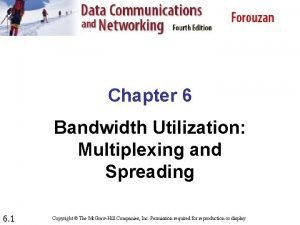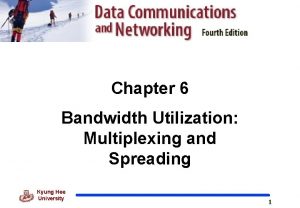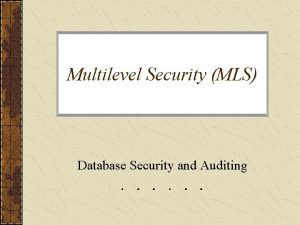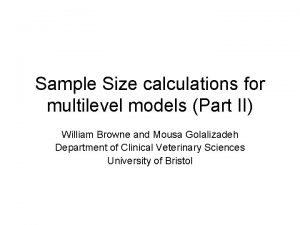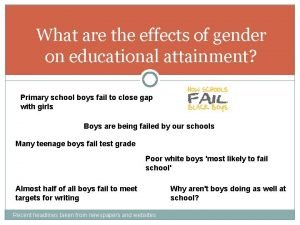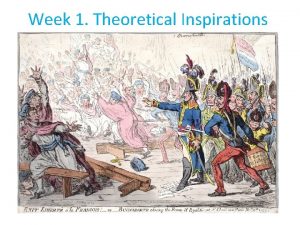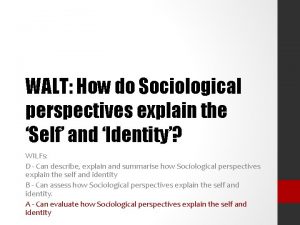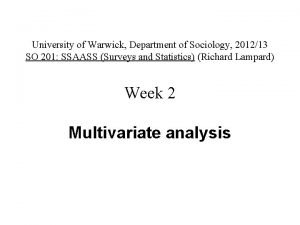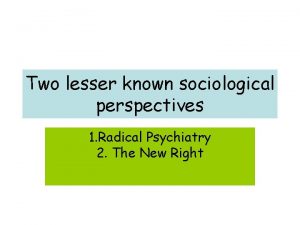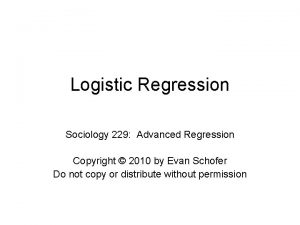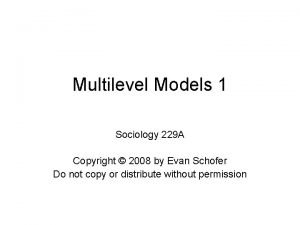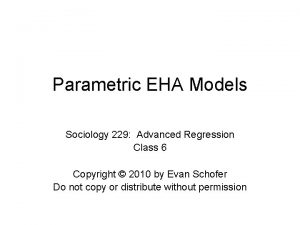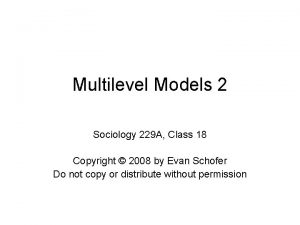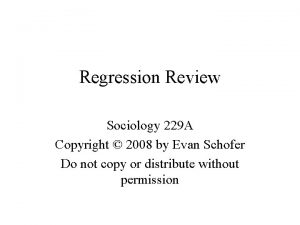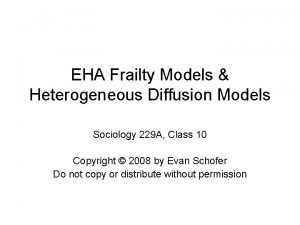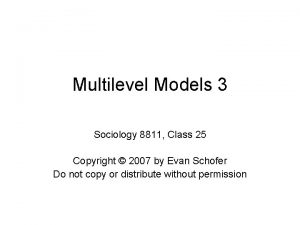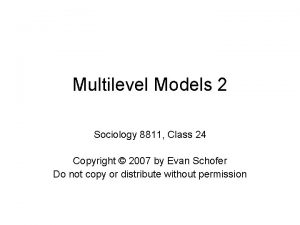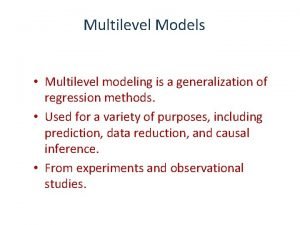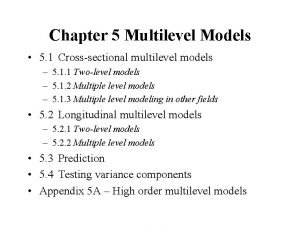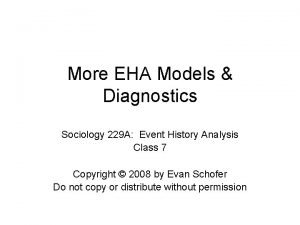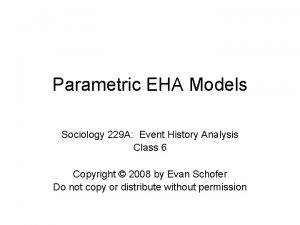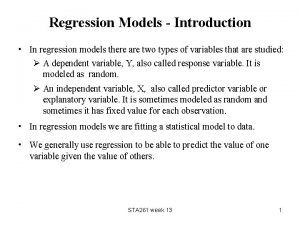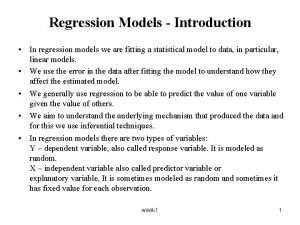Multilevel Models 2 Sociology 229 Advanced Regression Copyright




















































- Slides: 52

Multilevel Models 2 Sociology 229: Advanced Regression Copyright © 2010 by Evan Schofer Do not copy or distribute without permission

Announcements • Assignment 5 Handed out

Multilevel Data • Simpler example: 2 -level data Class Class • Which can be shown as: Class 1 Level 2 Level 1 S 2 Class 2 S 3 S 1 S 2 Class 3 S 1 S 2 S 3

Review: Multilevel Data: Problems • Issue: Multilevel data often results in violation of OLS regression assumption • OLS requires an independent random sample… • Students from the same class (or school) are not independent… and may have correlated error – Models tend to underestimate standard errors • This leads to false rejection of H 0. – When is multilevel data NOT a problem? • Answer: If you can successfully control for potential sources of correlated error

Multilevel Data: Research Purposes • Multilevel models are more than a “fix” for problems of OLS. Uses: – Raudenbush & Bryk 2002: 8 -9 – 1. Improved estimation of individual effects • Take advantage of pooling; between/within variance – 2. Modeling cross-level effects • Separating effects of individual-level variables from social context – 3. Partitioning variance-covariance components • An important descriptive issue: At what level is most of the variance?

Review: Multilevel Data • OLS: underestimated SEs • Robust Cluster SEs • A correction for OLS • Aggregation: Focus on “between group” effects • Loss of sample size • Watch for ecological fallacy • Fixed effects: “within group” effects • Random effects: Hybrid “within” & “between” • Requires strong assumption that Xs uncorrelated with error.

Fixed Effects Model (FEM) • Fixed effects model: • For i cases within j groups • Therefore aj is a separate intercept for each group • It is equivalent to solely at within-group variation: • X-bar-sub-j is mean of X for group j, etc • Model is “within group” because all variables are centered around mean of each group.

Random Effects • Issue: The dummy variable approach (FEM) treats group differences as a fixed effect • Alternatively, we can treat it as a random effect • Don’t estimate values for each case, but model it • This requires making assumptions – e. g. , that group differences are normally distributed with a standard deviation that can be estimated from data – Random effects models is a hybrid: a weighted average of between & within group effects • It exploits between & within information, and thus can be more efficient than FEM & aggregate models. – IF distributional assumptions are correct.

Random Effects • A simple random intercept model – Notation from Rabe-Hesketh & Skrondal 2005, p. 4 -5 Random Intercept Model • Where b is the main intercept • Zeta (z) is a random effect for each group – Allowing each of j groups to have its own intercept – Assumed to be independent & normally distributed • Error (e) is the error term for each case – Also assumed to be independent & normally distributed • Note: Other texts refer to random intercepts as uj or nj.

Linear Random Intercepts Model. xtreg supportenv age male dmar demp educ incomerel ses, i(country) re Random-effects GLS regression Group variable (i): country R-sq: within = 0. 0220 between = 0. 0371 overall = 0. 0240 Random effects u_i ~ Gaussian corr(u_i, X) = 0 (assumed) Assumes normal uj, uncorrelated with X vars Number of obs Number of groups = = 27807 26 Obs per group: min = avg = max = 511 1069. 5 2154 Wald chi 2(7) Prob > chi 2 625. 50 0. 0000 = = ---------------------------------------supportenv | Coef. Std. Err. z P>|z| [95% Conf. Interval] -------+--------------------------------age | -. 0038709. 0008152 -4. 75 0. 000 -. 0054688 -. 0022731 male |. 0978732. 0229632 4. 26 0. 000. 0528661. 1428802 dmar |. 0030441. 0252075 0. 12 0. 904 -. 0463618. 05245 demp | -. 0737466. 0252831 -2. 92 0. 004 -. 1233007 -. 0241926 educ |. 0857407. 0061501 13. 94 0. 000. 0736867. 0977947 incomerel |. 0090308. 0059314 1. 52 0. 128 -. 0025945. 0206561 ses |. 131528. 0134248 9. 80 0. 000. 1052158. 1578402 _cons | 5. 924611. 1287468 46. 02 0. 000 5. 672272 6. 17695 -------+--------------------------------sigma_u |. 59876138 SD of u (intercepts); SD of e; intra-class correlation sigma_e | 1. 8701896 rho |. 09297293 (fraction of variance due to u_i)

Linear Random Intercepts Model • Notes: Model can also be estimated with maximum likelihood estimation (MLE) • Stata: xtreg y x 1 x 2 x 3, i(groupid) mle – Versus “re”, which specifies weighted least squares estimator • Results tend to be similar • But, MLE results include a formal test to see whether intercepts really vary across groups – Significant p-value indicates that intercepts vary. xtreg supportenv age male dmar demp educ incomerel ses, i(country) mle Random-effects ML regression Number of obs = 27807 Group variable (i): country Number of groups = 26 … MODEL RESULTS OMITTED … /sigma_u |. 5397755. 0758087. 4098891. 7108206 /sigma_e | 1. 869954. 0079331 1. 85447 1. 885568 rho |. 0769142. 019952. 0448349. 1240176 ---------------------------------------Likelihood-ratio test of sigma_u=0: chibar 2(01)= 2128. 07 Prob>=chibar 2 = 0. 000

Choosing Models • Which model is best? • There is much discussion (e. g, Halaby 2004) • Fixed effects are most consistent under a wide range of circumstances • Consistent: Estimates approach true parameter values as N grows very large • But, they are less efficient than random effects – In cases with low within-group variation (big between group variation) and small sample size, results can be very poor – Random Effects = more efficient • But, runs into problems if specification is poor – Esp. if X variables correlate with random group effects – Usually due to omitted variables.

Hausman Specification Test • Hausman Specification Test: A tool to help evaluate fit of fixed vs. random effects • Logic: Both fixed & random effects models are consistent if models are properly specified • However, some model violations cause random effects models to be inconsistent – Ex: if X variables are correlated to random error • In short: Models should give the same results… If not, random effects may be biased – If results are similar, use the most efficient model: random effects – If results diverge, odds are that the random effects model is biased. In that case use fixed effects…

Hausman Specification Test • Strategy: Estimate both fixed & random effects models • Save the estimates each time • Finally invoke Hausman test – Ex: • • • xtreg var 1 var 2 var 3, i(groupid) fe estimates store fixed xtreg var 1 var 2 var 3, i(groupid) re estimates store random hausman fixed random

Hausman Specification Test • Example: Environmental attitudes fe vs re. hausman fixed random Direct comparison of coefficients… ---- Coefficients ---| (b) (B) (b-B) sqrt(diag(V_b-V_B)) | fixed random Difference S. E. -------+--------------------------------age | -. 0038917 -. 0038709 -. 0000207. 0000297 male |. 0979514. 0978732. 0000783. 0004277 dmar |. 0024493. 0030441 -. 0005948. 0007222 demp | -. 0733992 -. 0737466. 0003475. 0007303 educ |. 0856092. 0857407 -. 0001314. 0002993 incomerel |. 0088841. 0090308 -. 0001467. 0002885 ses |. 1318295. 131528. 0003015. 0004153 ---------------------------------------b = consistent under Ho and Ha; obtained from xtreg B = inconsistent under Ha, efficient under Ho; obtained from xtreg Test: Ho: difference in coefficients not systematic chi 2(7) = (b-B)'[(V_b-V_B)^(-1)](b-B) = 2. 70 Prob>chi 2 = 0. 9116 Non-significant pvalue indicates that models yield similar results…

Within & Between Effects • Issue: What is the relationship between within -group effects and between-group effects? • FEM models within-group variation • BEM models between group variation (aggregate) – Usually they are similar • Ex: Student skills & test performance • Within any classroom, skilled students do best on tests • Between classrooms, classes with more skilled students have higher mean test scores – BUT…

Within & Between Effects • But: Between and within effects can differ! • Ex: Effects of wealth on attitudes toward welfare • At the country level (between groups): – Wealthier countries (high aggregate mean) tend to have prowelfare attitudes (ex: Scandinavia) • At the individual level (within group) – Wealthier people are conservative, don’t support welfare • Result: Wealth has opposite between vs within effects! – Watch out for ecological fallacy!!! – Issue: Such dynamics often result from omitted level-1 variables (omitted variable bias) • Ex: If we control for individual “political conservatism”, effects may be consistent at both levels…

Within & Between Effects / Centering • Multilevel models & “centering” variables • Grand mean centering: computing variables as deviations from overall mean • Often done to X variables • Has effect that baseline constant in model reflects mean of all cases – Useful for interpretation • Group mean centering: computing variables as deviation from group mean • Useful for decomposing within vs. between effects • Often in conjunction with aggregate group mean vars.

Within & Between Effects • You can estimate BOTH within- and betweengroup effects in a single model • Strategy: Split a variable (e. g. , SES) into two new variables… – 1. Group mean SES – 2. Within-group deviation from mean SES » Often called “group mean centering” • Then, put both variables into a random effects model • Model will estimate separate coefficients for between vs. within effects – Ex: • egen meanvar 1 = mean(var 1), by(groupid) • egen withinvar 1 = var 1 – meanvar 1 • Include mean (aggregate) & within variable in model.

Within & Between Effects • Example: Pro-environmental attitudes. xtreg supportenv meanage withinage male dmar demp educ incomerel ses, i(country) mle Random-effects ML regression Group variable (i): country Random effects ~ Gaussian Between & withinu_i effects are opposite. Older countries are MORE environmental, but older people are LESS. Omitted variables? Wealthy European countries Log strong likelihood -56918. 299 with green =parties have older populations! Number of obs Number of groups = = 27807 26 Obs per group: min = avg = max = 511 1069. 5 2154 LR chi 2(8) Prob > chi 2 620. 41 0. 0000 = = ---------------------------------------supportenv | Coef. Std. Err. z P>|z| [95% Conf. Interval] -------+--------------------------------meanage |. 0268506. 0239453 1. 12 0. 262 -. 0200812. 0737825 withinage | -. 003903. 0008156 -4. 79 0. 000 -. 0055016 -. 0023044 male |. 0981351. 0229623 4. 27 0. 000. 0531299. 1431403 dmar |. 003459. 0252057 0. 14 0. 891 -. 0459432. 0528612 demp | -. 0740394. 02528 -2. 93 0. 003 -. 1235873 -. 0244914 educ |. 0856712. 0061483 13. 93 0. 000. 0736207. 0977216 incomerel |. 008957. 0059298 1. 51 0. 131 -. 0026651. 0205792 ses |. 131454. 0134228 9. 79 0. 000. 1051458. 1577622 _cons | 4. 687526. 9703564 4. 83 0. 000 2. 785662 6. 58939

Generalizing: Random Coefficients • Linear random intercept model allows random variation in intercept (mean) for groups • But, the same idea can be applied to other coefficients • That is, slope coefficients can ALSO be random! Random Coefficient Model Which can be written as: • Where zeta-1 is a random intercept component • Zeta-2 is a random slope component.

Linear Random Coefficient Model Both intercepts and slopes vary randomly across j groups Rabe-Hesketh & Skrondal 2004, p. 63

Random Coefficients Summary • Some things to remember: • Dummy variables allow fixed estimates of intercepts across groups • Interactions allow fixed estimates of slopes across groups – Random coefficients allow intercepts and/or slopes to have random variability • The model does not directly estimate those effects – Just as we don’t estimate coefficients of “e” for each case… • BUT, random components can be predicted after you run a model – Just as you can compute residuals – random error – This allows you to examine some assumptions (normality).

STATA Notes: xtreg, xtmixed • xtreg – allows estimation of between, within (fixed), and random intercept models • • xtreg y x 1 x 2 x 3, i(groupid) fe - fixed (within) model xtreg y x 1 x 2 x 3, i(groupid) be - between model xtreg y x 1 x 2 x 3, i(groupid) re - random intercept (GLS) xtreg y x 1 x 2 x 3, i(groupid) mle - random intercept (MLE) • xtmixed – allows random intercepts & slopes • “Mixed” models refer to models that have both fixed and random components • xtmixed [depvar] [fixed equation] || [random eq], options • Ex: xtmixed y x 1 x 2 x 3 || groupid: x 2 – Random intercept is assumed. Random coef for X 2 specified.

STATA Notes: xtreg, xtmixed • Random intercepts • xtreg y x 1 x 2 x 3, i(groupid) mle – Is equivalent to • xtmixed y x 1 x 2 x 3 || groupid: , mle • xtmixed assumes random intercept – even if no other random effects are specified after “groupid” – But, we can add random coefficients for all Xs: • xtmixed y x 1 x 2 x 3 || groupid: x 1 x 2 x 3 , mle cov(unstr) – Useful to add: “cov(unstructured)” • Stata default treats random terms (intercept, slope) as totally uncorrelated… not always reasonable • “cov(unstr) relaxes constraints regarding covariance among random effects (See Rabe-Hesketh & Skrondal).

STATA Notes: GLLAMM • Note: xtmixed can do a lot… but GLLAMM can do even more! • “General linear & latent mixed models” • Must be downloaded into stata. Type “search gllamm” and follow instructions to install… – GLLAMM can do a wide range of mixed & latentvariable models • Multilevel models; Some kinds of latent class models; Confirmatory factor analysis; Some kinds of Structural Equation Models with latent variables… and others… • Documentation available via Stata help – And, in the Rabe-Hesketh & Skrondal text.

Random intercepts: xtmixed • Example: Pro-environmental attitudes. xtmixed supportenv age male dmar demp educ incomerel ses || country: , mle Mixed-effects ML regression Group variable: country Wald chi 2(7) = 625. 75 Log likelihood = -56919. 098 Number of obs Number of groups = = 27807 26 Obs per group: min = avg = max = 511 1069. 5 2154 Prob > chi 2 0. 0000 = ---------------------------------------supportenv | Coef. Std. Err. z P>|z| [95% Conf. Interval] -------+--------------------------------age | -. 0038662. 0008151 -4. 74 0. 000 -. 0054638 -. 0022687 male |. 0978558. 0229613 4. 26 0. 000. 0528524. 1428592 dmar |. 0031799. 0252041 0. 13 0. 900 -. 0462193. 0525791 demp | -. 0738261. 0252797 -2. 92 0. 003 -. 1233734 -. 0242788 educ |. 0857707. 0061482 13. 95 0. 000. 0737204. 097821 incomerel |. 0090639. 0059295 1. 53 0. 126 -. 0025578. 0206856 ses |. 1314591. 0134228 9. 79 0. 000. 1051509. 1577674 _cons | 5. 924237. 118294 50. 08 0. 000 5. 692385 6. 156089 ---------------------------------------[remainder of output cut off] Note: xtmixed yields identical results to xtreg , mle

Random intercepts: xtmixed • Ex: Pro-environmental attitudes (cont’d) supportenv | Coef. Std. Err. z P>|z| [95% Conf. Interval] -------+--------------------------------age | -. 0038662. 0008151 -4. 74 0. 000 -. 0054638 -. 0022687 male |. 0978558. 0229613 4. 26 0. 000. 0528524. 1428592 dmar |. 0031799. 0252041 0. 13 0. 900 -. 0462193. 0525791 demp | -. 0738261. 0252797 -2. 92 0. 003 -. 1233734 -. 0242788 educ |. 0857707. 0061482 13. 95 0. 000. 0737204. 097821 incomerel |. 0090639. 0059295 1. 53 0. 126 -. 0025578. 0206856 ses |. 1314591. 0134228 9. 79 0. 000. 1051509. 1577674 _cons | 5. 924237. 118294 50. 08 0. 000 5. 692385 6. 156089 -----------------------------------------------------------------------------Random-effects Parameters | Estimate Std. Err. [95% Conf. Interval] ---------------+------------------------country: Identity | sd(_cons) |. 5397758. 0758083. 4098899. 7108199 ---------------+------------------------sd(Residual) | 1. 869954. 0079331 1. 85447 1. 885568 ---------------------------------------LR test vs. linear regression: chibar 2(01) = 2128. 07 Prob >= chibar 2 = 0. 0000 xtmixed output puts all random effects below main coefficients. Here, they are “cons” (constant) for groups defined by “country”, plus residual (e) Non-zero SD indicates that intercepts vary

Random Coefficients: xtmixed • Ex: Pro-environmental attitudes (cont’d). xtmixed supportenv age male dmar demp educ incomerel ses || country: educ, mle [output omitted] supportenv | Coef. Std. Err. z P>|z| [95% Conf. Interval] -------+--------------------------------age | -. 0035122. 0008185 -4. 29 0. 000 -. 0051164 -. 001908 male |. 1003692. 0229663 4. 37 0. 000. 0553561. 1453824 dmar |. 0001061. 0252275 0. 00 0. 997 -. 0493388. 049551 demp | -. 0722059. 0253888 -2. 84 0. 004 -. 121967 -. 0224447 educ |. 081586. 0115479 7. 07 0. 000. 0589526. 1042194 incomerel |. 008965. 0060119 1. 49 0. 136 -. 0028181. 0207481 ses |. 1311944. 0134708 9. 74 0. 000. 1047922. 1575966 _cons | 5. 931294. 132838 44. 65 0. 000 5. 670936 6. 191652 ---------------------------------------Random-effects Parameters | Estimate Std. Err. [95% Conf. Interval] ---------------+------------------------country: Independent | sd(educ) |. 0484399. 0087254. 0340312. 0689492 sd(_cons) |. 6179026. 0898918. 4646097. 821773 ---------------+------------------------sd(Residual) | 1. 86651. 0079227 1. 851046 1. 882102 ---------------------------------------LR test vs. linear regression: chi 2(2) = 2187. 33 Prob > chi 2 = 0. 0000 Here, we have allowed the slope of educ to vary randomly across countries Educ (slope) varies, too!

Random Coefficients: xtmixed • What if the random intercept or slope coefficients aren’t significantly different from zero? • Answer: that means there isn’t much random variability in the slope/intercept • Conclusion: You don’t need to specify that random parameter – Also: Models include a LRtest to compare with a simple OLS model (no random effects) • If models don’t differ (Chi-square is not significant) stick with a simpler model.

Random Coefficients: xtmixed • What are random coefficients doing? • Let’s look at results from a simplified model – Only random slope & intercept for education Model fits a different slope & intercept for each group!

Random Coefficients • Why bother with random coefficients? – 1. A solution for clustering (non-independence) – Usually people just use random intercepts, but slopes may be an issue also – 2. You can create a better-fitting model – If slopes & intercepts vary, a random coefficient model may fit better – Assuming distributional assumptions are met – Model fit compared to OLS can be tested…. – 3. Better predictions – Attention to group-specific random effects can yield better predictions (e. g. , slopes) for each group » Rather than just looking at “average” slope for all groups.

Random Coefficients • 4. Multilevel models explicitly put attention on levels of causality • Higher level / “contextual” effects versus individual / unit -level effects • A technology for separating out between/within • NOTE: this can be done w/out random effects – But it goes hand-in-hand with clustered data… • Note: Be sure you have enough level-2 units! – Ex: Models of individual environmental attitudes • Adding level-2 effects: Democracy, GDP, etc. – Ex: Classrooms • Is it student SES, or “contextual” class/school SES?

Multilevel Model Notation • So far, we have expressed random effects in a single equation: Random Coefficient Model • However, it is common to separate levels: Level 1 equation Intercept equation Gamma = constant u = random effect Slope Equation Here, we specify a random component for level-1 constant & slope

Multilevel Model Notation • The “separate equation” formulation is no different from what we did before… • But it is a vivid & clear way to present your models • All random components are obvious because they are stated in separate equations • NOTE: Some software (e. g. , HLM) requires this – Rules: • 1. Specify an OLS model, just like normal • 2. Consider which OLS coefficients should have a random component – These could be the intercept or any X (slope) coefficient • 3. Specify an additional formula for each random coefficient… adding random components when desired

Cross-Level Interactions • Does context (i. e. , level-2) influence the effect of level-1 variables? – Example: Effect of poverty on homelessness • Does it interact with welfare state variables? – Ex: Effect of gender on math test scores • Is it different in coed vs. single-sex schools? – Can you think of others?

Cross-level interactions • Idea: specify a level-2 variable that affects a level-1 slope Level 1 equation Intercept equation Slope equation with interaction Cross-level interaction: Level-2 variable Z affects slope (B 2) of a level-1 X variable g Coefficient 3 reflects size of interaction (effect on B 2 per unit change in Z)

Cross-level Interactions • Cross-level interaction in single-equation form: Random Coefficient Model with cross-level interaction – Stata strategy: manually compute cross-level interaction variables • Ex: Poverty*Welfare. State, Gender*Single. Sex. School • Then, put interaction variable in the “fixed” model – Interpretation: B 3 coefficient indicates the impact of each unit change in Z on slope B 2 • If B 3 is positive, increase in Z results in larger B 2 slope.

Cross-level Interactions • Pro-environmental attitudes. xtmixed supportenv age male dmar demp educ income_dev inc_mean. Xeduc ses || country: income_mean , mle cov(unstr) Mixed-effects ML regression Group variable: country Interaction between country mean income Number of obs = 27807 and individual-level education Number of groups = 26 supportenv | Coef. Std. Err. z P>|z| [95% Conf. Interval] -------+--------------------------------age | -. 0038786. 0008148 -4. 76 0. 000 -. 0054756 -. 0022817 male |. 1006206. 0229617 4. 38 0. 000. 0556165. 1456246 dmar |. 0041417. 025195 0. 16 0. 869 -. 0452395. 0535229 demp | -. 0733013. 0252727 -2. 90 0. 004 -. 1228348 -. 0237678 educ | -. 035022. 0297683 -1. 18 0. 239 -. 0933668. 0233227 income_dev |. 0081591. 005936 1. 37 0. 169 -. 0034753. 0197934 inc_mean. Xeduc|. 0265714. 0064013 4. 15 0. 000. 0140251. 0391177 ses |. 1307931. 0134189 9. 75 0. 000. 1044926. 1570936 _cons | 5. 892334. 107474 54. 83 0. 000 5. 681689 6. 102979 --------------------------------------- Interaction: inc_mean. Xeduc has a positive effect… The education slope is bigger in wealthy countries Note: main effects change. “educ” indicates slope when inc_mean = 0

Cross-level Interactions • Random part of output (cont’d from last slide). xtmixed supportenv age male dmar demp educ income_dev inc_mean. Xeduc ses || country: income_mean , mle cov(unstr) ---------------------------------------Random-effects Parameters | Estimate Std. Err. [95% Conf. Interval] ---------------+------------------------country: Unstructured | sd(income~n) |. 5419256. 2095339. 253995 1. 156256 sd(_cons) | 2. 326379. 8679172 1. 11974 4. 8333 corr(income~n, _cons) | -. 9915202. 0143006 -. 999692 -. 7893791 ---------------+------------------------sd(Residual) | 1. 869388. 0079307 1. 853909 1. 884997 ---------------------------------------LR test vs. linear regression: chi 2(3) = 2124. 20 Prob > chi 2 = 0. 0000 Random components: Income_mean slope allowed to have random variation Interceps (“cons”) allowed to have random variation “cov(unstr)” allows for the possibility of correlation between random slopes & intercepts… generally a good idea.

Beyond 2 -level models • Sometimes data has 3 levels or more • • Ex: School, classroom, individual Ex: Family, individual, time (repeated measures) Can be dealt with in xtmixed, GLLAMM, HLM Note: stata manual doesn’t count lowest level – What we call 3 -level is described as “ 2 -level” in stata manuals – xtmixed syntax: specify “fixed” equation and then random effects starting with “top” level • xtmixed var 1 var 2 var 3 || schoolid: var 2 || classid: var 3 – Again, specify unstructured covariance: cov(unstr)

Crossed Effects / 2 -way models • Sometimes data are not really nested… but crossed • Example: Longitudinal data: Individuals nested within countries and years • Strategies: – 1. Use a combination of fixed/random effects & manual dummies • Ex: Random effects for country, but dummies for years – 2. Estimate “two-way” variance component model • Random effects for country & year • In stata you have to do this manually (3 -level model) – See Rabe-Hesketh & Skrondal for an example.

Advice about building models • Raudenbush & Bryk 2002 – Start building the level 1 model first – Then build level 2 model • Keeping a close eye on level 2 N.

Beyond Linear Models • Stata can specify multilevel models for dichotomous & count variables – Random intercept models • • xtlogit – logistic regression – dichotomous xtpois – poisson regression – counts xtnbreg – negative binomial – counts xtgee – any family, link… w/random intercept – Random intercept & coefficient models – Plus, allows more than 2 levels… • xtmelogit – mixed logit model • xtmepoisson – mixed poisson model

Shared Frailty Models: EHA • Shared frailty model = random intercept in an event history model • Stata: stcox var 1 var 2 var 3, shared(cluster. ID) • Cluster ID variable could be country id, school id, etc… • Formula: Cox model with shared frailty • Where ui is a random variable for i groups • Parametric shared frailty models are similar…

Shared Frailty Models: EHA • Shared frailty (random effects) are useful for: – 1. Clustered data • Just like prior examples – 2. Models with repeated events • Repeated events is a kind of clustering within caseid • Again, dummy variables (FEM) is a reasonable option – In stata, you’d have to enter the dummies manually • Stata: specify cluster ID and form of frailty • stcox var 1 var 2, frailty(gamma) shared(schoolid) • streg var 1 var 2, dist(e) frailty(gamma) shared(schoolid)

Activity & Reading Discussion • Activity: Break into groups of 3 -4 (or so) • Design a study of student performance in advanced statistics classes • Imagine data (students) nested within sociology departments or universities (or both) • Explicitly theorize individual-level and contextual effects • Explicitly think of cross-level interactions – E. g. , contextual effects that amplify or diminish effects of a level-1 variable • Articles: • Schofer and Fourcade Gourinchas • Cohen and Huffman (handout)

Panel Data • Panel data is a multilevel structure • Cases measured repeatedly over time • Measurements are ‘nested’ within cases Person 1 Person 2 Person 3 Person 4 T 1 T 2 T 3 T 4 T 5 – Obviously, error is clustered within cases… but… – Error may also be clustered by time • Historical time events or life-course events may mean that cases aren’t independent – Ex: All T 1 s and all T 5 s • Ex: Models of economic growth… certain periods (e. g. , Oil shocks of 1970 s) affect all countries.

Panel Data • Issue: panel data may involve clustering across cases & time • Good news: Stata’s “xt” commands were made for this • Allow specification of both ID and TIME clusters… • Ex: xtreg var 1 var 2 var 3, mle i(countryid) t(year) – Note: You can also “mix and match” fixed and random effects • Ex: You can use dummies (manually) to deal with timeclustering with a random effect for case ids

Panel Data: serial correlation • Panel data may have another problem: • Sequential cases may have correlated error – Ex: Adjacent years (1950 & 1951 or 2007 & 2008) may be very similar. Correlation denoted by “rho” (r) • Called “autocorrelation” or “serial correlation” • “Time-series” models are needed • xtregar – xtreg, for cases in which the error-term is “first -order autoregressive” • First order means the prior time influences the current – Only adjacent time-points… assumes no effect of those prior • Can be used to estimate FEM, BEM, or GLS model • Use option “lbi” to test for autocorrelation (rho = 0? ).

Panel Data: Choosing a Model • If clustering is mainly a nuisance: • Adjust SEs: vce(cluster caseid) • Or simple fixed or random effects – Choice between fixed & random • Hausman test is one way to decide • Fixed is “safer” – reviewers are less likely to complain • But, if cross-sectional variation is of interest, fixed can be a problem… – In that case, use random effects… and hope the reviewers don’t give you grief – More on panel data next week!

 Advanced regression models
Advanced regression models Advanced regression models
Advanced regression models Advanced regression models
Advanced regression models What are multilevel security models?
What are multilevel security models? Cmput 229
Cmput 229 815-229-7246
815-229-7246 Cmput 229
Cmput 229 Cmput 229
Cmput 229 Iz 229
Iz 229 Simple and multiple linear regression
Simple and multiple linear regression Linear model regression
Linear model regression Logistic regression vs linear regression
Logistic regression vs linear regression Logistic regression vs linear regression
Logistic regression vs linear regression What is a functional form?
What is a functional form? Qualitative response regression models
Qualitative response regression models Probit model
Probit model Types of regression models
Types of regression models Modal and semi modals
Modal and semi modals Multi level page table
Multi level page table Teaching multilevel esl classes
Teaching multilevel esl classes Mlfq
Mlfq Multilevel model equation example
Multilevel model equation example Multilevel model equation example
Multilevel model equation example Multilevel paging in os
Multilevel paging in os Multilevel bus architecture in embedded systems
Multilevel bus architecture in embedded systems Multilevel page tables
Multilevel page tables Virtual memory linux
Virtual memory linux Multilevel modeling spss
Multilevel modeling spss Gantt chart in operating system
Gantt chart in operating system Multilevel indexing
Multilevel indexing Miller index visualizer
Miller index visualizer Multilevel nand gate
Multilevel nand gate Apa yang dimaksud dengan pewarisan inheritance
Apa yang dimaksud dengan pewarisan inheritance Multi level teaching examples
Multi level teaching examples Contoh multilevel inheritance
Contoh multilevel inheritance Multilevel multiplexing
Multilevel multiplexing Multilevel instruction
Multilevel instruction Multilevel scheme in data communication
Multilevel scheme in data communication Bandwidth utilization multiplexing and spreading
Bandwidth utilization multiplexing and spreading Multilevel database security
Multilevel database security Multilevel queue scheduling
Multilevel queue scheduling Mlpowsim
Mlpowsim Written report in research
Written report in research Functionalist perspective
Functionalist perspective Wilkinson genderquake sociology
Wilkinson genderquake sociology Ritualism sociology
Ritualism sociology Art with economics
Art with economics Gail schema
Gail schema Organic solidarity
Organic solidarity Looking glass self
Looking glass self Warwick sociology modules
Warwick sociology modules Radical psychiatry sociology
Radical psychiatry sociology Mechanical solidarity definition sociology
Mechanical solidarity definition sociology
